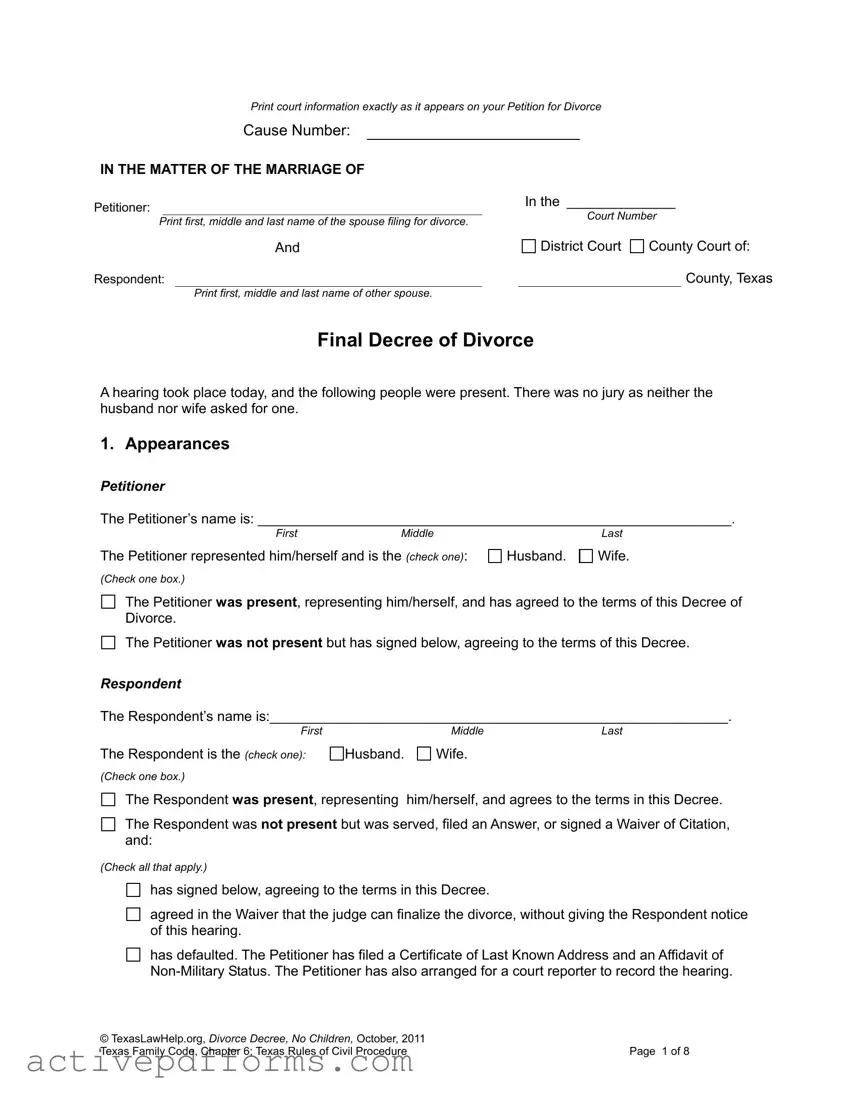6. Property And Debts
Note: Additional forms are needed to divide retirement benefits and to transfer title to real estate.
If you plan to divide retirement benefits or you jointly own a house or land with your spouse, do NOT use this form without first talking to a lawyer.
You can hire a lawyer just to give you advice and/or write the documents you need for a flat fee.
Call your local lawyer referral service or the State Bar of Texas Lawyer Referral Information Service at 1(800) 252-9690 for help finding a lawyer.
Texas is a community property state. This means that any new property or debt that either party obtains from the minute they are married until the minute the judge grants the divorce is community property, even if the property or debt is only in one spouse’s name.
All community property and debt should be included in the Final Decree of Divorce. There are a few exceptions to the law of community property. If either party receives a gift, an inheritance, or money from a lawsuit that does not compensate for lost wages, it is separate property. It is a good idea to confirm separate property obtained during the marriage as that individual’s separate property in the Final Decree of Divorce. More information about community and separate property can be found in the Texas Family Code, chapters 3,4, and 5.
The Court makes the following orders regarding the parties’ community and separate property:
Husband’s Property
Husband’s Separate Property
The Court confirms that the Husband owns the following property as his separate property: |
|
1. |
House located at: _______________________________________________________________ |
|
Street Address |
City |
State |
Zip |
|
Husband owned this house before marriage. |
|
|
|
|
Husband received this house as a gift or inheritance. |
|
|
2. |
Land located at: ________________________________________________________________ |
|
Street Address |
City |
State |
Zip |
Husband owned this land before marriage.
Husband received this land as a gift or inheritance.
3.Cars, trucks, motorcycles or other vehicles
Husband owned these vehicles before marriage or received them as a gift or inheritance during the marriage:
Year |
|
Make |
|
Model |
|
Vehicle Identification No. [VIN] |
|
|
|
|
|
|
|
|
|
|
|
|
|
|
|
|
|
|
|
|
|
|
|
|
|
|
|
|
|
|
|
|
4.Other Money or Property
Husband owned the following money or property before the marriage or inherited or received it as a gift during the marriage.
Husband received the following money from a lawsuit during the marriage. This money was not compensation for lost wages.













 Any insurance policy that covers the Wife’s life.
Any insurance policy that covers the Wife’s life.
 The Wife’s cars, trucks, motorcycles or other vehicles listed below:
The Wife’s cars, trucks, motorcycles or other vehicles listed below: